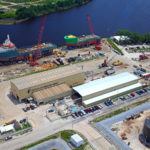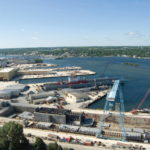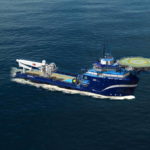Shipbuilding in the U.S. presents a dichotomy. Yards building large ocean going vessels struggle with the vicissitudes of the Jones Act. On the other hand, yards for smaller vessels see consistently brighter prospects, writes Barry Parker
It is well known that large ocean going Jones Act qualified vessels might cost three or four times the price[ds_preview] for a comparable vessel built in a reputable Asian yard. At the same time, facilities building competitively priced smaller vessels for harbors and the vast inland waterway/ river system have remained busy as the U.S. economy expands, ferries are seeing a surge in popularity, and increased oil exploration is in the wind.
All in all, in the States, shipbuilding continues to be vibrant. In particular, with offshore drilling likely to be expanded under the present Administration and with automobile gridlock giving rise to more ferry activity, the outlook is rosy for the shipbuilding business.
Deepsea – only two yards
The marketplace for large deepsea ships is limited to tankers with 45–50,000dwt vessels for the refined product trades predominating and containerships for the Puerto Rico, Alaska or Hawaii trades. The containership side of the business illustrates the serendipitous nature of this arena. In mid 2017, Tote Maritime had been strongly hinting that a four vessel order (2 firm, 2 options) with Philly Shipyard (PSI) for 3,700TEU bottoms to be deployed on the U.S. West Coast to Hawaii routes would be forthcoming. However, in January, Tote pulled the plug on the project, at least temporarily, citing difficulties in efforts to negotiate arrangements for land-side terminals in Hawaii. PSI, a one time yard for the U.S. Navy (which became Kvaerner Shipyard, and then Aker Shipyard, predecessors of the current company), had already started work on the two firm vessels. The project may be revived; the yard said: »PSI intends to resume this project when there is more clarity regarding the new order situation and related capital requirements.«
The business of building large commercial ships has been erratic over the past decades, with Oslo-listed Philly and NASSCO in San Diego being the last two yards standing. Since the late 1990s, PSI has delivered 28 vessels, including four 2,600TEU vessels for Matson, in the Jones Act containership trade, delivered in 2003–2006. The yard presently has two 3,600TEU vessels under construction for the same owner.
In addition, the yard has been very successful in building tankers for the Jones Act, most notably product tankers, drawing heavily on designs from Hyundai Mipo, for Overseas Shipholding Group (OSG), American Petroleum Tankers (APT, a division of Kinder Morgan) and Crowley Maritime. The APT and Crowley vessels are described as »LNG-ready«. The ten 46,000 dwt vessels built for OSG are »owned« by American Shipping Company, a financial owner which then places them on long term leases to the U.S. owner. Two additional vessels built at the yard – and fitted with bow loaders for Gulf of Mexico shuttle work at the Detyens Yard, in Charleston, S.C. – are also operated by OSG.
Nassco in San Diego, a division of behemoth contractor General Dynamics, builds both commercial and military ships. On the business side, its vessels have included 50,000 dwt product tankers – incorporating designs originating with Korean Daewoo group – for U.S. Shipping Partners (USS) with the vessels subsequently going to APC, for APC directly, and also for U.S. owner Seacor. On the container front, Nassco is the builder of two LNG fueled container ships, each 3,100TEU, utilized by Tote in the Puerto Rico trades, that entered the run in early 2016. Nassco states: »The ships were designed by DSEC, a subsidiary of Daewoo Shipbuilding & Marine Engineering (DSME), located in Busan, South Korea, and will include DSME’s patented LNG fuel-gas system and the world’s first order of a MAN ME-GI dual fuel slow speed engine.«
Construction has also begun on an order for Matson, active in the Hawaii trades, building two 3,500TEU vessels with RoRo capabilities. In a statement, the yard said: »Using proven design standards, the design incorporates liquefied natural gas-capable main and auxiliary engines, which are compliant with Tier III emission requirements. The design accommodates future installation of a LNG fuel gas system.«
Both yards have also built larger tankers for the waning Alaska oil trades, replacing 1970’s and 1980’s era single hulled crude carriers, with PSI building two 115,000 tonners for Exxon Mobil and Nassco building four 185,000 dwt vessels for BP during 2004 and 2006.
One yard on the Great Lakes, Bay Shipbuilding in Sturgeon Bay, Wisconsin (a subsidiary of Fincantieri Marine Group) has also played an important role in building vessels transporting refined products coastwise. Having constructed a series of Articulated Tug Barges (ATBs) for USS in the 2000’s, this yard has recently built two ATBs for Kirby Corporation (capacity of 155,000 barrels), and, in January 2018, delivered an ATB to Wawa Corporation, a convenience store operator with an extensive network for distributing gasoline (petrol). Bay Shipbuilding has also built ATBs for Moran Towing Corporation; they operate around the U.S. Gulf and Atlantic coast.
Success in Offshore and Brownwater
The great success stories in the U.S. marketplace can be found along the Gulf Coast, stretching from Florida into Texas. Eastern Shipbuilding, in Panama City, Fla. has been active across multiple sectors. Most recently, it has delivered dredges to Weeks Marine: (the 8,550 yd³ capacity Trailing Suction Hopper Dredger »Magdalen«) and Great Lakes Dredge and Dock, an ATB style Trailing Suction Hopper Dredger. The yard has built numerous Offshore Support Vessels (OSV), including for Harvey Gulf International, Hornbeck Offshore Services, and to Boldini S.A. Eastern Shipbuilding has cut steel on the first of three 4,500 passenger ferries to be used in New York City’s iconic Staten Island Ferry run.
Bollinger Shipyards, with a network of ten yards throughout southern Louisiana, has been a leader in building tugs, barges and OSVs (besides its work for the United States Coast Guard). Its customers include Crowley, Seacor, and Bouchard, active variously in ship assist and oil products transportation. Bee Mar, an entity operating Bollinger built OSVs in the U.S. Gulf, was divided up between Harvey and another operator, Edison Chouest.
The VT Halter yard, in Mississippi, has also been especially active building tugs and barges for the refined products transport businesses of Bouchard, Crowley and Tampa, Fla. based OSG. Its OSVs have been built for Crowley and Seacor. The yard is building two LNG fueled ConRo vessels (2,400TEU) for Crowley. The yard will also be building a barge that will deliver LNG to marine customers of Harvey Gulf’s nascent LNG supply business.
Other yards building OSV’s for Edison Chouest and others include North American Shipbuilding (in Louisiana), LaShip (in Louisiana), and Gulf Ship (in Gulfport, Mississippi). The Gulf Coast Shipyard Group (with yards in Mississippi and Louisiana), another builder of tugs, barges and offshore craft, was acquired by Harvey Gulf in 2015. It has now delivered six LNG fueled OSV’s that Harvey Gulf has placed on charters to oil majors who will deploy them in the deepwater offshore fields of the U.S. Gulf.
Passenger and Patrol
Throughout 2017, the passenger segment, and in particular high speed ferries, has seen a surge in activity. New York City has aggressively jump-started a ferry program, which complements the offerings of numerous private operators. Aluminum hulled catamarans were delivered from two facilities of Alabama-based Horizon Shipbuilding, which delivered 10 vessels. However, subsequently it slid into financial difficulties due to the tough contract terms and expedited delivery schedules. An additional six vessels were delivered during 2017 from another yard – Metal Shark– with quality issues emerging – likely also tied to the aggressive delivery schedule demanded by New York City. The success of the New York City ferry service has seen vessel sizes increased, with three boats (out of four additional vessels still to be constructed by Metal Shark) up-sized from 150 to 350 passenger capacity.
West Coast
On the U.S. West Coast, the San Francisco Bay area has also seen rapid expansion of its Water Emergency Transportation Authority (WETA) ferry network. Most recently, it has ordered six vessels each with 400 passenger capacity, and capable of 27kn speeds. Four of these will be built at facilities of the Vigor yards, a network of facilities throughout the Pacific Northwest. Another yard in the region, Dakota Creek Industries, which is well known for its construction of fishing trawlers, is building three 445 passenger Tier 4 boats capable of 34 knot speeds for WETA. Vigor is also building a quartet of RoPax ferries (1,500 pax/144 cars) for a major operator in its backyard: Washington State Ferries. Three are already in service and one additional vessel is still to be delivered in 2018.
A whole host of yards specialize in building smaller vessels. Besides its work with New York City, the Horizon yard has also been a mainstay in the tugboat business, building a handful of vessels for New York stalwart McAllister Towing. In the Delmarva region southeast of Washington DC, Chesapeake Bay Shipbuilding has delivered 16 ocean going tugboats to Vane Brothers, one of the largest movers of refined products on the U.S. East Coast, and recently secured a four ship order from the Baltimore based owner to construct four pusher tugs. The yard has a close relationship with American Cruise Lines, building several ocean going cruise vessels.
The successes of Metal Shark highlights another important marketplace: fast patrol boats for the military and for law enforcement. Its customers also include the USCG. On the West Coast, in Bellingham, Washington, All American Marine is a specialist in aluminum boats, encompassing ferries, crewboats, and patrol boats; its current construction includes two water-taxies, with capacity for 278 passengers, for the Seattle area.
The well-known Gladding Hearn yard, in Somerset, Massachusetts, has seen recent orders for boats from numerous pilotage organizations throughout the U.S. ranging from Homer, Alaska (Southwest Alaska Pilots), Port Huron, Michigan (Lake Pilots) to the Mississippi Delta (Associated Branch Pilots). This yard has also delivered a slew of passenger ferries (capacity 600) for clients including Circle Line (known for its boats circling Manhattan, in New York), and a series of high speed catamarans, with 493 passenger capacity, that will operate around Cape Cod, Martha’s Vineyard and Nantucket.
One up and coming segment features a new market segment: offshore wind installations. Another New England yard, Blount Boats, at the upper end of Narragansett Bay, Rhode Island, delivered an aluminum hulled catamaran which will ferry equipment, crews (but also tourists) between the shore and the »Deepwater Wind« project offshore near Block Island.
Barry Parker
























